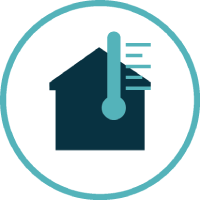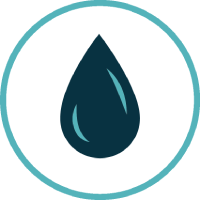Learn all about Cool Roof reflective coatings.
General
The roof is the most exposed surface of a building, as far as the entry of heat via solar radiation is concerned. Most industrial, supermarket and logistics activities require the construction of buildings with flat roofs, directly exposed to the sun. During the hot season, surface temperatures can exceed 80°C, causing a significant rise in indoor temperatures.
Protecting your roof means preventing premature wear and tear, and making a tangible contribution to the comfort of your building. What's more, it's the quickest and easiest way to beat the heat, and reduces the need for air conditioning.
A cooler roof lets less heat into the building: energy costs fall mechanically in air-conditioned spaces, which will require less air-conditioning. To quantify the energy savings and related bill reductions, a number of factors inherent to the context of each building must be taken into account. It should be noted, however, that savings can amount to as much as 40% of air-conditioning costs.
The return on investment from applying reflective paint varies according to the type of building and, above all, the activity it houses. The lower the temperature setpoint, the greater the impact of reflective paint, and the greater the energy savings.
Similarly, the building's existing insulation has a direct impact on savings: the older and thinner it is, the greater the impact of reflective paint. In this respect, applying reflective paint can make it possible to postpone renovation investments. This is all the more true as Covalba technology protects the roof from damage and fills any micro-cracks that may form.
To take a typical example of the return on investment of reflective paint, a hypermarket needing to maintain an interior temperature of 24°C can expect an ROI of around 5 years. A refrigeration building, on the other hand, requiring an interior temperature of 4°C, will have an ROI of around 2 to 3 years.
If we're talking about heat gain through the roof in winter, the gain is very small, as the sun is much lower in the sky and less intense. Passive solar heating is more likely to provide heat gain through the windows than through the roof. Secondly, winter days are shorter, and sunshine is both less long-lasting and less frequent. If the roof is covered in snow, the question no longer arises.
What's more, reflective paint doesn't in any way help to release the heat already contained inside: there's no risk of "heating leakage". Its only action is to limit the entry of external calories.
Before taking any concrete action, it is advisable to refer to the local PLU to ensure that the project is feasible in terms of the local architectural regulations.
As a general rule, flat-roofed industrial buildings in business parks can easily be given permission to change their roof color.
No! Unlike most waterproofing coatings, the application of our CovaTherm reflective paint poses no danger to your structure. Its low weight, between 0.8Kg/m2 and 1.2kg/m2, can be easily supported by all existing roofs.
A single-sided photovoltaic system on a dark roof loses yield in the hot season. Studies have shown that single-sided panels installed on a cooler roof, e.g. with a white or green roof, can increase yield by around 10%.
As for two-sided photovoltaic installations, their yield will also increase by 20% to 25%, thanks to the action of the reflective paint, which not only reduces the temperature experienced by the panel, but also reflects more light towards it (albedo).
CovaTherm is first and foremost a thermo-reflective coating and is not a dedicated solution for roof waterproofing: under no circumstances should it be considered as a main component of the roof's waterproofing system.
However, the coating is thick, elastic and highly resistant. It can fill microcracks of up to 2mm. Its application creates a continuous film that helps improve overall roof waterproofing and extends the life of coated materials by reducing thermal stresses and shocks.
An analysis of the run-off water was carried out by an accredited laboratory. The study proved that there are no traces of pollutants (or PFAS) in rainwater from a roof covered with Covalba paint.
Technical criteria
To clarify the importance of the SRI index, let's look at some basic concepts. Solar reflectance describes a surface's ability to reflect solar radiation back to the atmosphere. This applies to both visible and invisible light (especially UV rays).
Reflectance is measured as a percentage: a commercially available white paint with high reflectance can reflect up to 75% of the sun's rays during its period of maximum effectiveness (wear and tear and deposits will rapidly blacken it). CovaTherm technology, on the other hand, reflects 94% of solar radiation.
Thermal emittance represents a material's capacity to emit heat previously absorbed in the form of thermal radiation. The higher the emittance percentage (index between 0 and 1), the more heat is released. CovaTherm reflective paint allows 88% of the heat received to be reflected back, keeping covered surfaces cool.
The solar reflectance index is a value that represents a roof's ability to reject solar heat. An index is determined by a calculation according to ASTM 1980, which takes into account measured solar reflectance and thermal emissivity.
SRI values generally range from 0 to 100, with particularly hot materials reaching a negative value, while particularly cold materials will exceed 100. Please note that SRI does not apply to vertical surfaces such as walls, due to the nature of the calculation, which is based on a horizontal surface.
With an SRI = 119 when new and SRI = 118 when aged, CovaTherm is the best-performing reflective roof coating in Europe.
All our components are REACH-compliant and authorized in Europe, with no substances classified as "substances of concern" under REACH.
Care and durability
The answer is no! Our white roof coating incorporates a technology that protects the roof from the elements, reduces dirt adherence and prevents the development of moss: the system contains an anti-fouling, self-cleaning topcoat. An annual check, plus a rinse with water if necessary, will ensure that no disruptive elements have interfered with the action of our process.
Covalba applies a protective layer to the reflective paint: CovaTherm Top Coat, whose self-cleaning properties reduce soiling from surrounding pollution. As a result, the roof remains bright white over the years, retaining its ability to reflect the sun's rays.
We do, however, recommend that you carry out an annual inspection of your roof to check that no external elements are interfering with the perfect whiteness of the reflective paint you've applied. At the same time, we recommend that you clean your roof with water to remove any particles that may have accumulated on the coating and improve its solar reflection performance...
Installation of the CovaTherm roofing system by our certified applicators is covered by a two-year warranty. This takes into account the perfect adhesion of the system to its substrate.
The accelerated aging test of 4000 hours of exposure in a QUV enclosure (SRI in aged condition) proves that reflective performance is maintained at the same level as when new.
The CovaTherm Top Coat (UV and natural dirt protection) guarantees reflectivity for up to 20 years. We recommend rinsing the roof with water once a year.
Applying Covalba's cool roof paint to waterproofing under warranty does not imply any structural modification or change in use. The ten-year warranty is therefore maintained.


